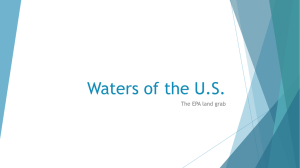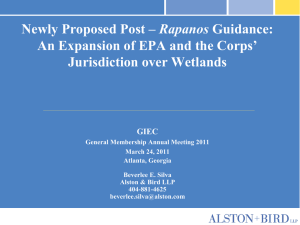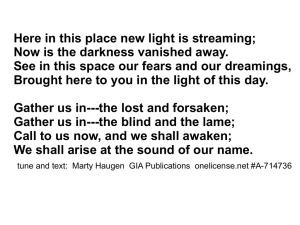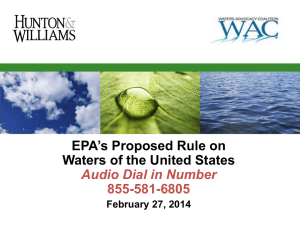here - American Soybean Association
advertisement
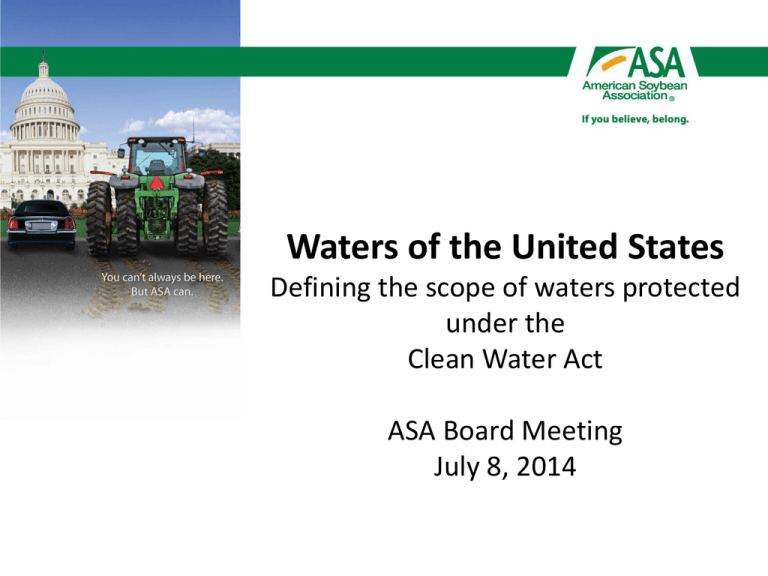
Waters of the United States Defining the scope of waters protected under the Clean Water Act ASA Board Meeting July 8, 2014 What Are Waters of the US? • 40 CFR 122.2: For purposes of the Clean Water Act, "Waters of the United States" means: • (a) All waters which are currently used, were used in the past, or may be susceptible to use in interstate or foreign commerce, including all waters which are subject to the ebb and flow of the tide; • (b) All interstate waters, including interstate "wetlands"; • (c) All other waters such as interstate lakes, rivers, streams (including intermittent streams), mudflats, sandflats, wetlands, sloughs, prairie potholes, wet meadows, playa lakes, or natural ponds the use, degradation, or destruction of which would affect or could affect interstate or foreign commerce including any such waters: “All Other Waters” continued… • • • • • • • • (1) Which are or could be used by interstate or foreign travelers for recreational or other purposes; (2) From which fish or shellfish are or could be taken and sold in interstate or foreign commerce; or (3) Which are used or could be used for industrial purposes by industries in interstate commerce; (d) All impoundments of waters otherwise defined as waters of the United States under this definition; (e) Tributaries of waters identified in paragraphs (a) through (d) of this definition; (f) The territorial sea; and (g) Wetlands adjacent to waters (other than waters that are themselves wetlands) identified in paragraphs (a) through (f) of this definition. Waste treatment systems, including treatment ponds or lagoons designed to meet the requirements of CWA are not waters of the United States. Why Now? – Supreme Court rulings in 2001 and 2006 created uncertainty about the scope of the CWA • Solid Waste Agency of Northern Cook County v. U.S. Army Corps of Engineers (SWANCC) (2001), • Rapanos v. United States (2006) – What’s “in”? What’s “out”? – Supreme Court urged EPA and Corps to initiate a rulemaking “Guidance” documents • EPA/Corps issued guidance in 2003 and 2008 – Intended to lessen confusion – Still in place • 2011 proposed guidance issued but never finalized • Which waters are jurisdictional? Which are not? Which require a case-by-case determination? What does the proposed rule say? • Would revise the existing administrative definition of “waters of the United States” in regulations consistent with legal rulings— especially the recent Supreme Court cases—and science concerning the interconnectedness of tributaries, wetlands, and other waters to downstream waters and effects of these connections on the chemical, physical, and biological integrity of downstream waters. • Focused on clarifying the regulatory status of waters located in isolated places in a landscape, the types of waters with ambiguous jurisdictional status following the Supreme Court’s 2001 ruling in SWANCC, and small streams, rivers that flow for part of the year, and nearby wetlands, the types of waters affected by the Court’s 2006 ruling in Rapanos. Section 1: Defining WOTUS The following waters would be jurisdictional by rule, or, categorically jurisdictional: • Waters susceptible to interstate commerce, known as traditional navigable waters (no change from current rules); • All interstate waters, including interstate wetlands (no change); • The territorial seas (no change); • Impoundments of the above waters or a tributary, as defined in the rule (no change); • Tributaries of the above waters (these waters are jurisdictional under current rules, but the term “tributary” is newly and broadly defined in the proposal); • All waters, including wetlands, that are adjacent to a water identified in the above categories (more inclusive because not limited to simply adjacent wetlands). Other Waters “Other waters” applies to wetlands and non-wetland waters that do not fall into the category of waters susceptible to interstate commerce (traditional navigable waters), interstate waters, the territorial seas, tributaries, or waters adjacent to waters in one of these four categories. Current regulations contain a non-exclusive list of “other waters,” such as intrastate lakes, mudflats, prairie potholes, and playa lakes. EPA and the Corps are asking for comment on whether to conclude by rule that certain types of “other waters”—prairie potholes, western vernal pools, Carolina and Delmarva bays, pocosins, Texas coastal prairie wetlands, and perhaps other categories of waters—have significant nexus and are per se jurisdictional. Controversy over “Other Waters” To what degree are “other waters” jurisdictional? Under the 2003 and 2008 guidance, all “other waters” require a case-by-case evaluation to determine if a significant nexus exists, ie jurisdictional. Uncertainty as to what degree “other waters” that are similarly situated may be aggregated or combined for a significant nexus determination. Since issuing these guidance documents, the agencies have not found jurisdiction over any “other water” based solely on significant nexus. In the proposed rule, “other waters,” including wetlands, that are adjacent to a jurisdictional water are categorically jurisdictional. Non-adjacent “other waters” and wetlands will continue to require a case-by-case determination of significant nexus. Also, the proposed rule allows broader aggregation of “other waters” that are similarly situated than under the existing which could result in more “other waters” being found to be jurisdictional following a significant nexus evaluation. Section Two: Exclusions These would not be jurisdictional even if they would otherwise be included within categories that are jurisdictional. 1. Waste treatment systems, including treatment ponds or lagoons, that are designed to meet CWA requirements (no change from current rules); 2. Prior converted cropland (no change); 3. A list of features that have been excluded by long-standing practice and guidance and would now be excluded by rule, such as artificially irrigated areas that would revert to upland should application of irrigation water to the area cease; 4. Two types of ditches: ditches that are excavated wholly in uplands, drain only uplands or non-jurisdictional waters, and have less than perennial (i.e., permanent) flow; and ditches that do not contribute flow, either directly or through another water, to a traditional navigable water, interstate water, impoundment, or the territorial seas. 5. Other ditches, if they meet the rule’s definition of “tributary,” would continue to be “waters of the United States”—a point of much controversy with some stakeholders. Exemptions, continued No change to existing statutory and regulatory exclusions: 1. Exemptions for normal farming, ranching, and silviculture activities such as plowing, seeding, and cultivation (CWA §404(f)); 2. Exemptions for permitting of agricultural stormwater discharges and return flows from irrigated agriculture; 3. Exemptions for water transfers that do not introduce pollutants into a waterbody; 4. Permitting processes. Economic Impact EPA and the Corps estimate that, overall, approximately 3% of U.S. waters would additionally be subject to CWA jurisdiction as a result of the proposed rule, compared with current field practice, and thus subject to CWA requirements. The estimated increase includes about 17% of “other waters” that were not jurisdictional under the 2003/2008 guidance, as well as the result of assuming that all tributary streams and adjacent wetlands are jurisdictional. Timeline • Proposed rule published April 21, 2014 • Comment deadline postponed to October 20, 2014 • Final rule? 2016 or beyond ASA’s Plan of Action • Hired outside counsel to draft comments – Will focus on questions of whether EPA/Corps are exceeding their authority • EPA Deputy Administrator Perciasepe speaking tomorrow • Webinar with EPA Office of Water Acting Administrator Nancy Stoner tentatively scheduled for Wednesday, July 30, 1:00 – 2:30 EST Sources: Congressional Research Service: 1. EPA and the Army Corps’ Proposed Rule to Define “Waters of the United States” Claudia Copeland, Specialist in Resources and Environmental Policy, June 10, 2014 2. The Wetlands Coverage of the Clean Water Act (CWA): Rapanos and Beyond Robert Meltz, Legislative Attorney and Claudia Copeland, Specialist in Resources and Environmental Policy, April 22, 2014


